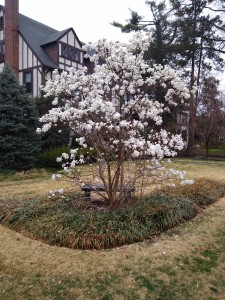 The spring beauty of star magnolia flies in the face of epidemics and uncertainty. They are the first magnolias to open their petals as the air warms up, offering up cascades of “stars”–actually showy flowers composed of multiple slender petals. Most often those petals are white, but occasionally you will see a pink-flowered specimen. All star magnolias, or Magnolia stellata, as they are known to the botanically minded, perfume the spring breezes with a sweet, light scent.
The spring beauty of star magnolia flies in the face of epidemics and uncertainty. They are the first magnolias to open their petals as the air warms up, offering up cascades of “stars”–actually showy flowers composed of multiple slender petals. Most often those petals are white, but occasionally you will see a pink-flowered specimen. All star magnolias, or Magnolia stellata, as they are known to the botanically minded, perfume the spring breezes with a sweet, light scent.
Star magnolias emigrated from their native Japan and were introduced in the United States in 1862. They were first mentioned in an 1890 nursery catalog issued by the New Jersey-based Henderson Nursery. Its owner, Peter Henderson, then at the end of a long life and career, was a well-known figure in American horticulture. His two successful books, Gardening For Profit and Practical Floraculture were hits with the gardening public.
Star magnolia was also a hit, catching on because of its many virtues. It is showy enough to be massed in large spaces, but compact enough to stand out as a specimen tree in a small garden. Mature stellatas top out at no more than 20 feet tall and 15 feet wide. They can be grown as large shrubs, but are most frequently seen as small trees. Because of their small size, they are good curbside specimens and grow low enough so that they won’t disturb overhead power lines.
Like many magnolias, the stellatas emerge from the cold weather months with soft, fuzzy buds containing the nascent flowers. When those flowers pop open they exude fragrance that is compelling without being overpowering. The scent is a good argument for positioning star magnolias close to houses, patios, walkways and other gathering areas. Once their moment of spring glory fades, stellata flowers give way to knobby, two-inch long seed pods that eventually ripen and split, revealing round orange seeds. Though the pods are not nearly as showy as the flowers, they add to the overall attraction of the plant. Smooth gray bark is easy on the eye, as are the dark green, ovoid leaves, which turn yellow in the fall before leaving the scene.
According to Michael Dirr, in his invaluable Manual of Woody Landscape Plants, breeders have introduced a good many star magnolia varieties. However, many of them are relatively hard to find. Probably the most common is ‘Royal Star’, which features pinkish buds that open to fat white flowers with up to 30 petals apiece. Introduced in the 1950’s, it is popular enough to persist among Monrovia Nursery’s current offerings. ‘Royal Star’s parent, ‘Waterlily’, is another popular variety. The buds are dark rose-pink and the flowers are white. ‘Waterlily’ features fewer and thinner petals than ‘Royal Star’, but compensates with an upright growth habit. According to Dr. Dirr, ‘Waterlily’ flowers a bit later than its royal offspring.
I am very partial to ‘Rosea’, which is light pink flowers and is reputedly quite cold hardy. It was once the most readily available of the pink-flowered varieties. I would also love to see, buy and grow ‘Dawn’. Dr. Dirr notes that each long white petal is adorned with a pink stripe, which persists over the life of the flower. Some well-stocked nurseries may carry it, but I have yet to find an online source.
Introduced to honor the one hundredth anniversary of Harvard’s famed Arnold Arboretum, ‘Centennial’ boasts very large flowers that may be over five inches across with up to thirty petals. Those petals are white blushed with pink, which mark ‘Centennial’ as the offspring of ‘Rosea’. While some stellata varieties seem to have an innate fondness for shrubby growth, ‘Centennial’ is much more upright and tree-like.
All stellatas have similar cultural requirements. They thrive best in sunny locations that are sheltered from excessive wind. Unlike some other ornamental trees, stellatas are not fussy about soil conditions, though rich, well-drained soil is always best. Regular water is a good idea while the tree is getting established, but star magnolias are somewhat drought tolerant thereafter.
If you want to see stars next spring, make your choice now. Good local nurseries should carry at least one variety, and many of those nurseries will deliver your choice to your door. Nurseries that stock Monrovia plants may carry ‘Royal Star’. To find a Monrovia retailer near you, go to http://www.monrovia.com. ForestFarm carries ‘Waterlily’. Find them at 14643 Watergap Rd, Williams, OR 97544, (541) 846-7269; www.forestfarm.com. Gossler Farms Nursery carries the pink-flowered ‘Jane Platt’, which won the Royal Hortcultural Society’s Award of Garden Merit (AGM) for overall performance. This may be as close as you will get to ‘Rosea”. Gossler Farms is at 1200 Weaver Rd, Springfield, OR 97478; (541) 746-3922; www. gosslerfarms.com.
